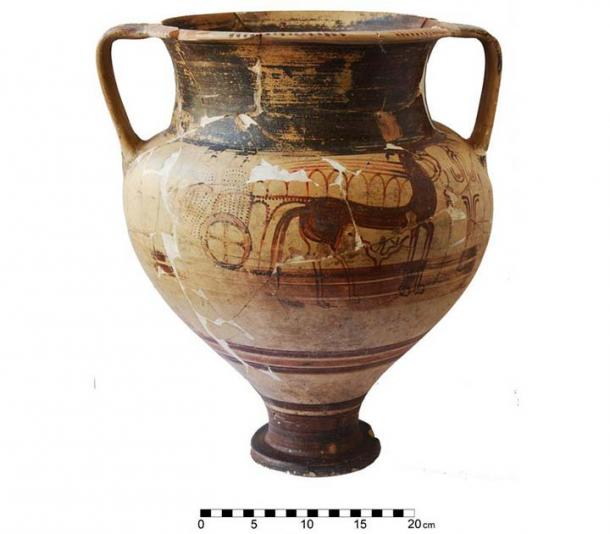An archaeological expedition from the University of Gothenburg has announced the finding of underground tombs in Cyprus. Initially, the Swedish archaeologists identified a set of mysterious chambers using magnetometry. But now, they have revealed that they were actually “royal tombs” laden in luxury imported artifacts and were located outside the Bronze Age trading metropolis, Hala Sultan Tekke.
Located on the south coast of Cyprus, on the banks of the Larnaca Salt Lake which is near the coastal city of Larnaca, Hala Sultan Tekke is an important Muslim shrine which is today revered as the final resting place of Umm Haram, the prophet Muhammad’s paternal aunt. Featuring Ottoman and Islamic architecture , “the Tekke” comprises a mosque, mausoleum and a serene courtyard. However, this site was an ancient center of copper trading between 1500 BC and 1300 BC. Thanks to the recent discovery of royal tombs in Cyprus, the final resting place of the ancient elites who controlled copper production and trading on the island have been discovered.

One of the skeletons discovered in the tomb in Cyprus. (P. M. Fischer / Public domain )
Scanning the Cyprus Tombs of Ancient Copper Elites
The Swedish Söderberg expedition, which has been excavating in Hala Sultan Tekke since 2010, had previously identified chamber tombs in Cyprus loaded with valuable grave goods. However, the newly discovered chamber tombs are on another level of importance, because “over 500 superb quality grave goods” were recovered.
Unique Cyprus Death Cult Treasures Uncovered at Mass Burial Site 2,400-Year-Old Aristocrat Family Tomb Uncovered in Cyprus Sheds Light on Ancient Soloi
In a University press release , Professor of Archaeology and team leader, Peter Fischer, said the collection of tombs in Cyprus was discovered just outside the 50-hectare Bronze Age city. The researcher said the location was scanned after many pieces of broken pottery had been ploughed by farmers. Using magnetometers, which identify stone structures and artifacts up to two meters beneath ground level, the researchers revealed the chambers measuring up to 4 by 5 meters (13.12 ft by 16.40 ft), which were accessed via a narrow passage from the surface.

The excavations of the tombs in Cyprus in progress. (P. M. Fischer / Public domain )
Excavating Hoards of Imported Treasures at Tombs in Cyprus
According to Peter Fischer, many of the grave goods were embellished with “precious metals, gems, ivory and high-quality ceramics.” Several well-preserved skeletons were found within the Cyprus tombs , including a woman surrounded by ceramic vessels, jewelry and a circular bronze mirror that was once highly-polished.
Furthermore, lying beside the woman were the remains of a one-year-old child, with a ceramic toy beside her. It was discovered that the gold and ivory inlays found on many of the grave goods were sourced in Egypt, while precious blue lapis lazuli, dark red carnelian and blue-green turquoise would have been mined in Afghanistan, India and Sinai. Meanwhile, the pieces of amber which they unearthed within the tombs in Cyprus had been imported from the Baltic region.

Large Mycenaean (Greek) “Chariot krater” (c. 1350 BC) discovered in elite tomb in Cyprus. (P. M. Fischer / Public domain )
Cyprus Tombs Reveal the Royal Egyptian Connection
Most of the ceramic vessels were made in Greece, but some of the pots had been imported from Turkey, Syria, Palestine and Egypt. Also recovered from the tombs were high-quality bronze weapons, some of which were inlaid with ivory, while a gold-framed seal was manufactured with haematite inscribed with the names of gods and rulers.
Which Invading Elite Are Buried in Cyprus’ Monumental Tombs of the Kings? Copious Copper Supplies Made Cyprus a Trading Center 3,500 Years Ago
Some of the skeletons wore diadems, a type of ornamental headband or crown normally worn by royalty, or high-ranking individuals, in Egypt. Some of the diadems were skillfully decorated with “bulls, gazelles, lions and flowers,” and according to the press release the remains of other people within the tomb in Cyprus were found wearing high quality necklaces with pendants. The researchers think that most of these items of jewelry were made in Egypt during the 18th Dynasty, during the reigns of pharaohs Thutmos III, Amenophis IV (Akhenaten) and his wife, Queen Nefertiti.
Bronze Age Copper Elites Within Tombs in Cyprus
The researchers concluded that the “vast wealth” of the interred individuals probably came from the production of copper, the ore of which came from the Troodos Mountains in Cyprus. After refinement, the city exported copper in large quantities to surrounding cultures who mixed it with tin, to make the more durable alloy, bronze.
Peter Fischer said that while little is known about the social hierarchy between 1500 BC and 1300 BC in Bronze Age Cyprus, there is “no doubt,” that those people interred in the tombs belonged to the city’s ancient government, and that many of the recovered bodies belonged to the elites (royals) who controlled the copper trade.